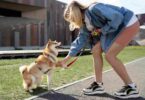Aggression in dogs is one of the most challenging behaviors to manage, yet it’s also one of the most misunderstood. It can manifest in many forms—growling, snapping, biting, or even lunging—but it’s important to remember that aggression is often a symptom, not the root cause. Whether triggered by fear, territorial instincts, or frustration, the key to addressing aggression is understanding its underlying causes and approaching it with patience, consistency, and the right techniques.
1. The Root Causes of Aggression: A Complex Web of Emotions
Aggression doesn’t simply arise out of nowhere. It’s a multifaceted issue that is often rooted in fear, anxiety, or frustration. A dog may become aggressive if it feels threatened, cornered, or if its territory is being encroached upon. Aggression can also result from pain or illness, making it important to rule out medical conditions as the primary cause. A dog may show aggression if it has had negative experiences with other dogs or people in the past, or if it’s simply not well-socialized. Understanding the cause of the aggression is crucial before any attempts to correct it. Aggression is never a one-size-fits-all problem—it’s as unique as the dog displaying it.
2. Reading Canine Body Language: The Subtle Signs of Stress
Before aggression escalates into a full-blown incident, dogs often display subtle signs of stress and discomfort. These signs may include stiffening of the body, a raised hackle, averted eyes, or lip curling. Understanding these early warning signals can allow you to intervene before the situation gets out of control. The key here is awareness—dog owners must be in tune with their dog’s body language to spot discomfort or anxiety early. The more attuned you are, the better equipped you’ll be to manage aggression before it turns into an aggressive outburst.
3. Positive Reinforcement: Encouraging Calm Behavior
When it comes to managing aggression, punishment rarely works and often makes the situation worse. Instead, positive reinforcement is the most effective way to encourage calm, desirable behaviors. When your dog behaves calmly or exhibits signs of relaxation in the presence of a trigger—whether it’s another dog, a stranger, or a new environment—reward that behavior. Positive reinforcement helps dogs associate the presence of a potential trigger with something pleasant. Over time, this can help shift their response from aggression to calmness. This method requires patience, but with consistency, it works wonders in reshaping your dog’s behavior.
4. Desensitization and Counter-Conditioning: Rewiring the Response
Desensitization and counter-conditioning are two powerful techniques used to change a dog’s emotional response to a trigger. In desensitization, you gradually expose the dog to the source of their aggression (whether it’s other dogs, people, or specific situations) at a low intensity, increasing the exposure as the dog becomes more comfortable. The goal is to reduce the emotional charge associated with the trigger. Meanwhile, counter-conditioning involves pairing the trigger with something positive—like treats or praise—so that the dog learns to associate the previously negative stimulus with something rewarding. Over time, these techniques can help rewire your dog’s response, replacing aggression with calm or neutral behavior.
5. Managing Resources: Reducing Territorial Aggression
One of the most common types of aggression is resource guarding, where a dog becomes possessive of food, toys, or even its space. This territorial aggression can be especially problematic in multi-dog households or environments where there’s a lot of competition for resources. The key to managing this type of aggression is to establish clear boundaries and predictability in your dog’s environment. Feed your dog in a quiet, secure place where it feels safe, and make sure toys and other resources are rotated to avoid competition. Teaching the “leave it” command and reinforcing it with rewards helps to prevent escalation when the dog feels possessive. A calm, assertive energy from you, the owner, is also essential. Dogs are highly attuned to their owner’s energy, and if you project confidence and control, your dog is more likely to follow suit.
6. Socialization: Preventing Aggression Before It Starts
Socialization is perhaps the most effective way to prevent aggression from developing in the first place. Puppies should be exposed to a variety of people, animals, environments, and experiences at an early age to help them become well-rounded, confident adults. However, socialization doesn’t stop after puppyhood—it’s an ongoing process. Even adult dogs can benefit from carefully managed exposure to new experiences and situations. Dogs that are well-socialized are less likely to react aggressively because they are comfortable in different settings and with different stimuli. It’s never too late to start socializing your dog, but the earlier you begin, the better.
7. Consistency and Patience: The Heart of Behavioral Change
Managing aggression isn’t something that happens overnight. It’s a slow process that requires consistent effort, patience, and a deep understanding of your dog’s needs. Whether you’re using positive reinforcement, desensitization, or behavior modification techniques, you must be consistent in your approach. Any mixed signals can confuse your dog and hinder progress. It’s also important to remember that aggression is not always a behavior that can be entirely “fixed.” Some dogs may always have a tendency to be more reactive or protective. The goal is not to eliminate aggression entirely, but to manage it effectively so that it doesn’t interfere with the quality of life for you or your dog.
8. Professional Help: Knowing When to Seek Guidance
While many aggressive behaviors can be managed with the right approach, there are situations where professional help is necessary. If your dog’s aggression is severe or escalating despite your best efforts, it may be time to consult with a professional dog trainer or a veterinary behaviorist. These experts have the tools, experience, and knowledge to address more complex cases of aggression, especially when the aggression is linked to medical issues or deep-seated behavioral problems. Seeking professional help is not a sign of failure—it’s a proactive step toward ensuring the safety and well-being of your dog, your family, and others in the community.




